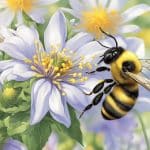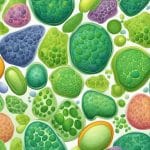Types Of Moss
Types of moss are small, non-vascular plants that are commonly found in damp environments such as forests, swamps, and bogs. They are members of the Division Bryophyta, which includes liverworts and hornworts. Unlike vascular plants that have roots, stems, and leaves, mosses do not have true roots or stems and rely on direct absorption of water and nutrients from their environment.
Mosses are an ancient group of land plants that reproduce by spores. They have a unique life cycle with two distinct stages: the haploid gametophyte stage and the diploid sporophyte stage. The gametophyte stage is the dominant phase of the life cycle, and it is during this stage that mosses produce spores, which then grow into new gametophytes. Mosses are also nonvascular, which means that they do not have specialized tissues for transporting water and nutrients. Instead, they rely on diffusion and osmosis to move water and nutrients throughout their bodies.
Key Takeaways
- Mosses are small, non-vascular plants that are members of the Division Bryophyta.
- They have a unique life cycle with two distinct stages: the haploid gametophyte stage and the diploid sporophyte stage.
- Mosses are nonvascular and rely on diffusion and osmosis to move water and nutrients throughout their bodies.
Moss Classification

Mosses are classified into two main groups based on their growth pattern: Acrocarpous and Pleurocarpous mosses.
Acrocarpous Moss
Acrocarpous mosses are characterized by their upright growth pattern, which resembles miniature conifer trees. They have a non-branching stem and square-shaped cells in their leaves. The sporophytes, which are responsible for spore production, grow at the end of the stem.
Pleurocarpous Moss
Pleurocarpous mosses, on the other hand, have a prostrate growth pattern and often form dense mats. They have a branching stem and oval-shaped cells in their leaves. The sporophytes grow on the side of the stem.
Mosses are part of the division Bryophyta, which includes other non-vascular plants such as liverworts and hornworts. They are found in moist and shady areas around the world, except in salt water. Mosses are known for their ability to carpet forest floors and woodland areas.
Overall, mosses are an essential part of the ecosystem, providing habitats for insects and other small creatures. They also play a crucial role in soil formation and nutrient cycling.
Moss Habitats
Mosses can be found in a variety of habitats, ranging from moist environments to rock gardens and woodlands. In this section, we will explore some of the most common habitats where mosses thrive.
Moist Environments
Mosses are most commonly found in moist environments like rainforests and near running water. They require a constant supply of moisture to survive and thrive. In fact, mosses can absorb up to 20 times their own weight in water. This ability allows them to survive in areas where other plants cannot.
Rock Gardens
Mosses are also commonly found in rock gardens. They can grow on rocks, walls, and other hard surfaces. Mosses are ideal for rock gardens because they require very little soil to grow. They can also add color and texture to rock gardens, making them more visually appealing.
Woodlands
Mosses are best known for those species that carpet woodland and forest floors. They are commonly found in shady locations where the soil is moist and rich in organic matter. Mosses play an important role in woodland ecosystems by providing habitat for insects, spiders, and other small animals.
In the United States, mosses can be found in a variety of habitats, ranging from the forests of the Pacific Northwest to the deserts of the Southwest. Mosses are also commonly found in wetlands, bogs, and other wetland habitats.
Overall, mosses are incredibly versatile plants that can thrive in a variety of habitats. Whether you are looking to add color and texture to your rock garden or create a lush woodland landscape, mosses are an excellent choice.
Cultivation and Care
Watering and Moisture
Mosses are low-maintenance plants that require consistent moisture to grow well. Gardeners should water mosses regularly, especially during dry weather. However, it’s important not to overwater mosses, as this can lead to waterlogging and root rot.
Light and Shade
Most mosses thrive in shady, damp environments, making them ideal for growing in areas with limited sunlight. However, some species of moss can tolerate more light than others. Gardeners should research the light requirements of their chosen moss species before planting.
Soil and Nutrients
Mosses can grow in a variety of soil types, but they prefer acidic soils with a pH between 5.0 and 6.0. Gardeners should ensure that their soil is well-draining and has good air circulation to prevent waterlogging. Mosses do not require fertilizer, but they can benefit from the addition of organic matter, such as leaf litter or compost.
Overall, growing moss is a simple and rewarding process that requires minimal effort. With proper watering, light, and soil conditions, gardeners can cultivate a lush, green carpet of moss that adds a touch of natural beauty to any landscape or garden.
Popular Moss Species
Moss is a versatile plant that comes in different species, each with its unique features and characteristics. In this section, we will discuss some of the popular moss species, including cushion moss, haircap moss, and feather moss.
Cushion Moss
Cushion moss, also known as Leucobryum glaucum, is a type of moss that forms dense, compact cushions. It is a common species found in humid and shady areas, including forests, rocks, and soil. Cushion moss has a greenish-yellow color and can grow up to 10 cm in height.
Haircap Moss
Haircap moss, scientifically known as Polytrichum commune, is a type of moss that forms clumps or mats. It is a common species found in moist and shady environments, including forests, wetlands, and bogs. Haircap moss has a bright green color and can grow up to 30 cm in height.
Feather Moss
Feather moss, also known as Pleurozium schreberi, is a type of moss that forms feathery tufts. It is a common species found in forests and tundra regions. Feather moss has a light green color and can grow up to 20 cm in height.
Common Haircap and Spoon-Leaved Moss are other popular moss species that are worth mentioning. Common Haircap, also known as Polytrichum commune, is a type of haircap moss that forms dense mats. It is a common species found in moist and shady environments. Spoon-Leaved Moss, scientifically known as Bryum argenteum, is a type of moss that forms mats or tufts. It is a common species found in soil, rocks, and walls.
In summary, cushion moss, haircap moss, and feather moss are some of the popular moss species. Each species has unique features and characteristics that make it stand out. Moss is a versatile plant that can thrive in various environments, making it a great addition to any garden or landscape.
Moss in Culture and Design
Moss is not only a beautiful plant but also a versatile one. It has been used in various cultural and design contexts, from Japanese gardens to modern terrariums. This section explores some of the most popular uses of moss in culture and design.
Terrariums
Terrariums are miniature ecosystems that are easy to maintain and can be used as decorative pieces in any household. Moss is a popular plant to use in terrariums because it is low-maintenance and adds a touch of greenery. Mosses like cushion moss, fern moss, and sheet moss are commonly used in terrariums because of their small size and easy adaptability to different environments.
Green Roofs
Green roofs are becoming increasingly popular in urban areas as a way to combat the heat island effect and reduce energy consumption. Moss is a great plant to use on green roofs because it is low-maintenance, requires no soil, and can withstand extreme weather conditions. Mosses like haircap moss, rock cap moss, and sheet moss are commonly used on green roofs because of their ability to absorb and retain water.
Floral Arrangements
Moss is also a popular plant to use in floral arrangements because of its unique texture and color. Mosses like mood moss and cushion moss are commonly used in floral arrangements because of their soft texture and vibrant green color. Moss can be used as a base for floral arrangements or as a decorative element to add texture and depth.
In conclusion, moss is a versatile plant that can be used in various cultural and design contexts. From terrariums to green roofs, moss adds a touch of greenery and texture to any space. Whether you are a gardening enthusiast or a designer, moss is a plant worth considering for your next project.






